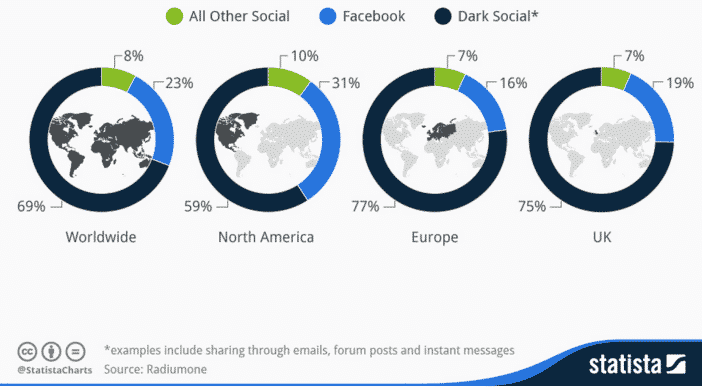While the term ‘Dark Social’ evokes images of Darth Vader using social media to recruit for the Empire, the reality is—fortunately—a lot less sinister.
First coined in 2012 by Alexis Madrigal in an article published by The Atlantic, the term, in fact, refers to the increasingly common practice of sharing links to articles and products via private messages rather than in public posts on social networks. Millions of people actively engage in this every day, sending high volumes of traffic to publishers. However, links shared privately lack referral tags, which means they are extremely difficult to track. When you look at your analytics platform, these Dark Social shares show up simply as ‘direct’ traffic.
Although Google states that ‘direct’ traffic happens when users type a URL directly into their browser or click on a bookmarked site, the reality is, it’s a fallback for any source of traffic without referral data. To highlight the scale of the issue, a study by RadiumOne found that “84% of consumers’ outbound sharing from publishers’ and marketers’ websites now takes place via private, Dark Social channels such as email and instant messaging.”

What can you do about it?
With figures like this, it’s important publishers get a handle on Dark Social. While you may not be able to fully track this traffic, here are three things you can do to help build a better picture of what is actually going on:
Step One—Define how much of your direct traffic is actually Dark Social
A good starting point is to add a UTM (Urchin Tracking Module) code to links. This is essentially a URL with added tracking parameters (such as utm_source, utm_medium, utm_campaign), which allows you to capture reporting data about the referring campaign. Standard UTM parameters in a referral link are then used to track source attribution, enabling you to see what specific source and campaign triggered a customer action. Armed with this information, you can look at your direct traffic for these long links. If you find them, it’s fair to assume they were not typed in manually, and actually originate from Dark Social.
Step Two—Direct people where you want them to go
Another tactic to help you manage Dark Social is to include highly visible sharing buttons on content to encourage viewers to share things on specific channels such as email, WhatsApp, iPhone messenger and Facebook messenger (and, of course, add specific tracking codes for each). Also keep an eye on other social platforms’ performance in your analytics platform. A spike in your ‘direct’ traffic coinciding with a spike in a specific social platform can indicate where your Dark Social traffic is actually coming from.
Step three—Employ Dark Social tools to give you better visibility
From all your analysis, if you find that a lot of traffic to your site originates from Dark Social, you might want to investigate other options for more support. There are currently a number of tools on the market that you can use to track Dark Social traffic origins and analyze their outcomes, including:
1. Po.st
Po.st is owned and operated by RadiumOne and not only allows users to share content but also provides them with dark social analytics tools.
2. ShareThis
ShareThis offers a tool that enables people to share web content with friends via email, direct message, or text message, and can be customized to measure copy and shares of your URLs. This is an effective tactic to mitigate and actually track shares via dark social.
3. GetSocial.io
GetSocial.io is a SaaS-based Dark Social media analytics platform that allows you to track dark social shares of your content across all devices by simply inserting a snippet of code on your site. This is your one-stop shop when looking to track, analyze and make strategic decisions based on sharing in the dark social space.
While Dark Social may seem perplexing, when tracked correctly private URL shares can provide publishers with invaluable insight into consumers’ real interests, allowing them to identify content that is sparking interest and the influencers that are actually generating conversions.
As dark social traffic continues to emerge as a powerful conversion tool, it will become increasingly important for publishers and brands alike to understand it and take advantage of everything it has to offer.

